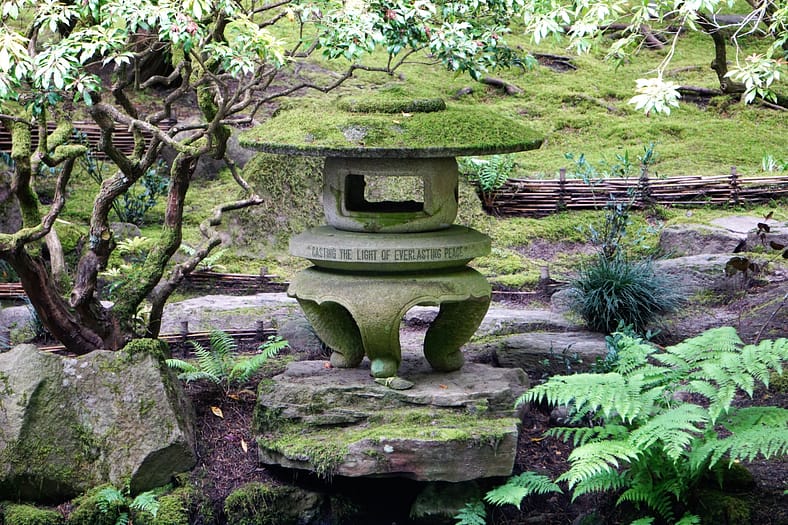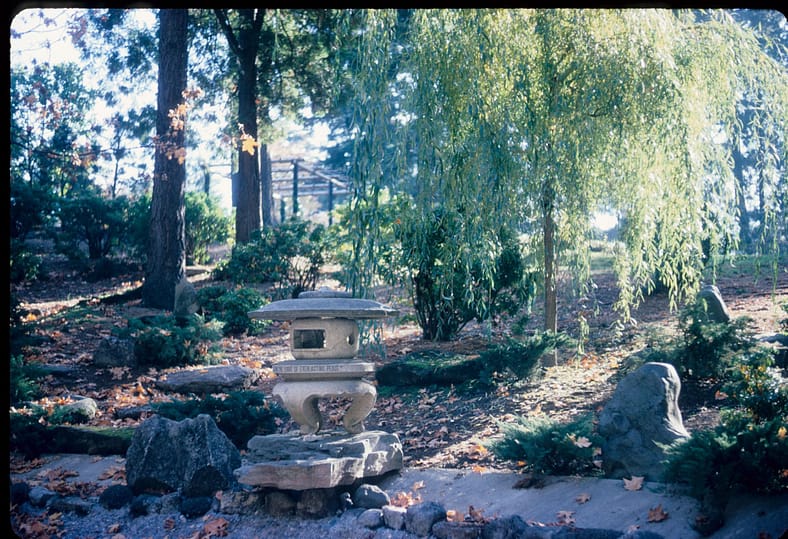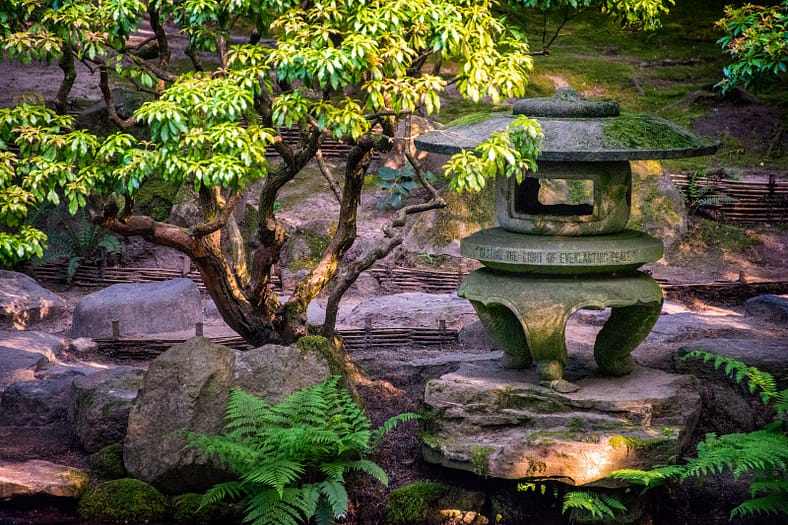Presentation of Peace Lanterns to Hiroshima, Nagasaki, and Tokyo

9/20/22: This story was updated to include photos of Japan Institute’s presentation of peace lanterns in Hiroshima and Nagasaki.
On the eastern bank of the upper portion of the Strolling Pond Garden, a stately yukimi doro (a stone lantern with tripod legs) stands among evergreen shrubs, ferns, and dappled sunlight. Stylized in the snow lantern form, the lantern’s firebox is directly underneath a broad sloping roof resembling a traditional Japanese hat made from rush (kasa). In English, a message of hope is inscribed in capital letters: CASTING THE LIGHT OF EVERLASTING PEACE. This lantern, referred fondly as the Peace Lantern, first took a voyage across the Pacific Ocean before finding its home in Portland Japanese Garden.
In 1954, not even a decade past the conclusion of World War II, Mayor Ryōzō Hiranuma of Yokohama, Japan began gifting stone lanterns to different locations around the world to “cast the light” of peace. The ship that conveyed this gesture to Portland, Oregon would be the first Japanese vessel to arrive in the area since World War II. During a presentation of the lantern to Portland, His Excellency, Japan’s Ambassador to the United States, Sadao Iguchi, shared that he hoped “that the stone lantern will serve in the future as a cornerstone on which everlasting friendship and amity between the United States of America and Japan will be firmly built up.” Portland Mayor Fred L. Peterson shared a similar sentiment, voicing his hope that the lantern would symbolize that the U.S. and Japan “can continue in peace, happiness, and mutual progress.”
At first, the lantern was installed in the International Rose Test Garden. However, with racist hostility toward Japan and its people still festering, the Peace Lantern became the subject of routine vandalism. Finally, in 1967, the lantern was moved to Portland Japanese Garden’s Strolling Pond Garden, where it has remained to this day. While its journey home to Portland concluded more than 50 years ago, the Peace Lantern’s significance has not waned. Rather, it has inspired the generations that followed.

In September, Japan Institute of Portland Japanese Garden will present exact replicas of the Peace Lantern to the cities of Hiroshima, Nagasaki, and Tokyo ahead of Japan Institute’s Peace Symposium, “Peacemaking at the Intersection of Culture, Art, and Nature” in Tokyo.
“After Hiroshima and Nagasaki were bombed in World War II, many atomic researchers were worried that the cities would be essentially unlivable for the most part of a century,” Portland Japanese Garden’s Arlene Schnitzer Curator of Culture, Arts, and Education, Aki Nakanishi shared. “But it only took them 15 years to recover and now they’re bustling and important cities. Not only have these cities shown incredible resilience, but both have also become world leaders in spreading the message of peace.”
Peace Lantern Dedications in Hiroshima & Nagasaki, September 2022
Tokyo will be presented a Peace Lantern, a fitting location not only because it’s Japan’s capital, but because the city has similarly reached out with gifts of friendship in the past. “In the early twentieth century, Tokyo Mayor Yukio Ozaki was instrumental in sending Washington D.C. its famous cherry trees,” Nakanishi continued. “In planning the recipients of the peace lanterns, we knew we had to include Tokyo. The lantern will go on the site of the International House of Japan, a world leader in building platforms for peaceful dialogue, as well as a friend and partner of Portland Japanese Garden.”
This is not the first time Portland Japanese Garden has presented peace lanterns. In 2017, as Yokohama was preparing for Japan’s Annual National Urban Greenery Fair, Portland Japanese Garden Chief Curator and Director of the Japanese Garden Training Center, Sadafumi Uchiyama was approached for advice from his sensei, landscape architecture expert Professor Isoya Sinji. “Professor Sinji did not want just flowers in a garden for the Urban Greenery Fair,” Uchiyama said. “He was looking for a symbol; something tangible. He believes that landscape has everything to do with human culture and the acknowledgement of history. Over dinner one night I mentioned, ‘we have our stone lantern from Yokohama,’ and that was it. That is how it started.”

After receiving approval from then-Mayor Fumiko Hayashi, Yokohama sent stone masons Tetsuro Tanabe and Hideo Araki to Portland Japanese Garden to get precise measurements of the peace lantern. The two experts would make an identical replica back in Japan. On March 25, 2017, the peace lantern was installed in Higa-en, a small yet handsome park in the city.
“Portland Japanese Garden was founded on the principle that cultural exchange between community members and civilians can build a resilient peace,” Nakanishi continued. “We’ve seen it work for almost 60 years. Now is the time to grow even more connections and build a brighter future, together.”

Keeping the Craft of Stone Lanterns Vibrant
Stone lanterns came to Japan from China at the same time Buddhism was introduced. Initially, these lanterns were more functional than ornamental and helped provide light in a land without access to electricity. As the modern world developed, these lanterns eventually became pleasing aesthetic touches, especially in Japanese gardens. However, not many new stone lanterns are being commissioned today.
Nakanishi notes that this adds even more significance to the presentation of the peace lanterns. “Japan Institute is an American organization raising funds to help assist and steward design integral to Japanese culture,” he shared. “We’re helping nurture this homegrown craftsmanship so the rest of the world can continue to enjoy it.”

Peace Symposium: Peacemaking at the Intersection of Culture, Art, and Nature
Japan Institute will hold six Peace Symposia on six continents over the course of three years. The first and inaugural event will be in Tokyo, Japan on Wednesday, September 21 – the International Day of Peace. The second event will be in London, England on Monday, December 6th. These symposia will explore the interplay between and convergence of landscapes, architecture, and arts in shaping new civic conversations and efforts for peacebuilding through cultural diplomacy. More information on these exciting gatherings can be found here.












